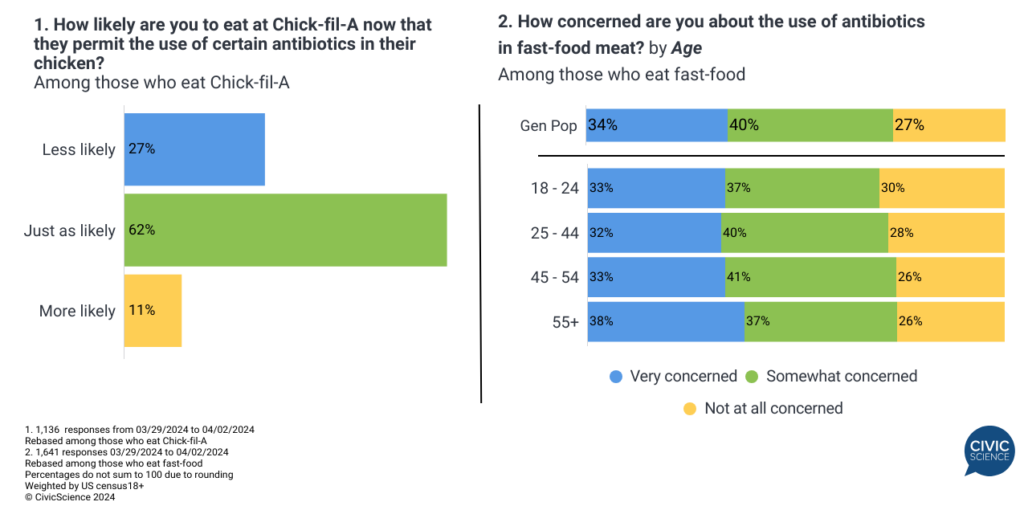Last week, Chick-fil-A announced that the fast-food restaurant would soon allow some antibiotics in its chicken, citing supply concerns for high-quality chicken. The move signifies a shift from the brand’s “No Antibiotics Ever” pledge to “No Antibiotics Important To Human Medicine,” which means antibiotics would only be used in cases where the animal or those around it were to become sick, and the antibiotics would be required to have cleared the animal’s system before it is allowed to become available for the food supply. How will consumers respond to Chick-fil-A’s shift away from 100% antibiotic-free chicken?
Most Chick-fil-A customers aren’t deterred, but fast-food diners are leery of antibiotics in fast-food meat overall.
CivicScience finds that the majority of Chick-fil-A patrons (62%) are just as likely to eat there following the announcement as they were before the change. That said, more than a quarter say they are now ‘less’ likely to eat Chick-fil-A.
The vast majority of fast-food restaurant diners, however, are at least ‘somewhat’ concerned about antibiotics in fast-food meat, including more than a third who are ‘very’ concerned. This concern carries across all age groups and income levels, with Boomers, Gen Xers, and those making $100K+ per year most likely to be concerned.

Is antibiotic-free actually healthier? Americans aren’t sure.
Roughly 3-in-10 of those who eat meat believe that antibiotic-free meat is, in fact, healthier than conventional meat. The plurality (34%), though, say they’re unsure whether antibiotic-free means healthier. Twenty-two percent report they believe meat free of antibiotics is not any healthier than meat treated with antibiotics, while 13% say antibiotic-treated meat is the healthier option. These beliefs do differ across political lines – Democrats are 10 percentage points more likely than Republicans to believe that antibiotic-free meat is healthier.

Grocery shoppers prioritize antibiotic-free meat, but it’s not the most common target when shopping for meat.
CivicScience polling shows meat that is labeled as ‘locally sourced’ is the most common choice meat-eating grocery shoppers look for, followed by ‘grass-fed/pasture-raised’ and ‘antibiotic-free/no antibiotics.’

Cast Your Vote: Do you think that 100% antibiotic-free meat is healthier than meat that has been treated with antibiotics?
While the use of antibiotics in livestock is heavily regulated, research suggests there are risks, such as the increase of antibiotic-resistant bacteria. Although those who typically eat at Chick-fil-A aren’t as concerned that the chain will be using chicken treated with antibiotics, it does shape purchasing decisions as fast-food diners do take notice and grocery store shoppers place emphasis on looking for it when they’re shopping.
Want to see more in-depth QSR and grocery insights like these? CivicScience clients have access to the InsightStore™ database with over 500K crossable, always-on questions. See how your brand can leverage it here.








